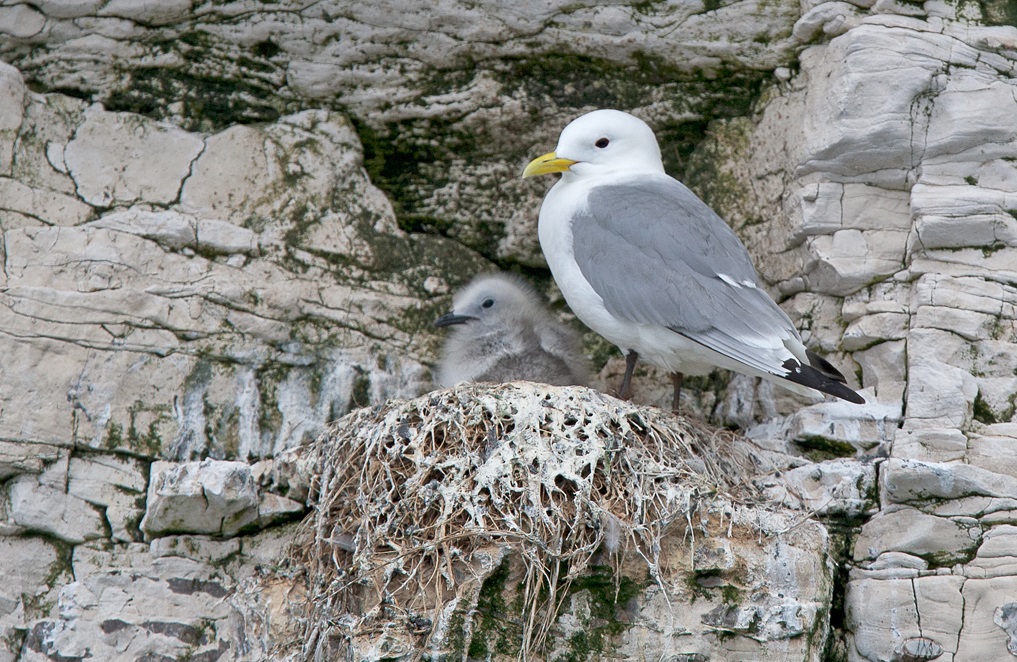Nature suddenly bursts into life bringing fresh green shoots, leaves and flowers, the heady scent of wild garlic in woodlands, while the sounds of bird song and bleating lambs fill the air.
The famed Farndale wild daffodils appear alongside the river Dove in time for Easter, subject to the weather of course! They're said to have been planted by the monks from nearby Rievaulx Abbey. Wild daffodils are smaller and more delicate, and the trumpet shaped flower is a paler yellow.
Our tip
Head to the coast to see kittiwakes, guillemots, razorbills, gannets, fulmar, shag and everyone’s favourite – the puffin – returning to the Yorkshire cliffs after spending the winter out at sea. Kittiwakes, razorbills and fulmar nest on Cowbar Nab headland, sheltering the picturesque fishing village of Staithes. As there is no direct access to Cowbar Nab, these are best viewed with a pair of binoculars from the harbour wall in Staithes below Cowbar Nab.
Head further south to Flamborough Cliffs and Bempton Cliffs to enjoy the sight of puffins nesting, or marvel at the only mainland gannet breeding colony in England at Bempton Cliffs. These large streamlined white birds are renowned for plunging into the sea at astonishing speeds when they hunt for fish. They pair for life and return to the same nest. By midsummer the huge colony is an amazing sight, sound and smell!

Also look out for:
- Blackthorn, one of the earliest trees to blossom, with a froth of clustered white flowers on thorny branches appearing before the leaves have burst bud. Make a note of it flowering now in woodland, scrub and hedgerows, then remember to come back in the autumn to harvest some of its fruits – sloes – to make traditional sloe gin!
- The soft, bubbling call of the curlew really heralds the start of spring. This ground nesting bird prefers wet marshlands, rough grassland and moors. Look out for overhead flocks – easy to spot with their long curved beaks. The North York Moors has one of the UK's highest density of breeding curlew on open moorland so you've got a good chance of seeing them on any moorland walk. You'll also find them in the Howardian Hills in the Coxwold-Gilling Gap, Dalby Bush Fen and the River Derwent floodplains.
- Ring ouzels will be arriving on the moors around Rosedale, Farndale and Spaunton having flown back from their wintering grounds in Spain and north west Africa. This bird is in decline and this is one of just a few upland areas where they still breed. See a blackbird with a distinct white bib flying up out of the heather? It’s a ring ouzel. They favour dense ground cover so count yourself lucky if you see this charismatic little bird. Find out how the Land of Iron landscape partnership project has supported these birds.
- Emperor moths are spectacular orange and yellow day-flying moths with striking eyespot patterns on their four wings, emerging from cocoons on the moors on warm April days, having fed on heather the previous year. Spot them in the Hole of Horcum or at Fen Bog, near Goathland.
Walk of the month
Follow our famous Daffodil walk from Low Mill to Church Houses; you'll find them along the riverbanks and in the churchyard at Church Houses.
Fantastic wild daffodil displays also appear in Rosedale and Hell Bank Wood near Appleton le Moors. Equally stunning are the planted displays in the grounds of Castle Howard in the Howardian Hills or along the riverbanks in Helmsley.
